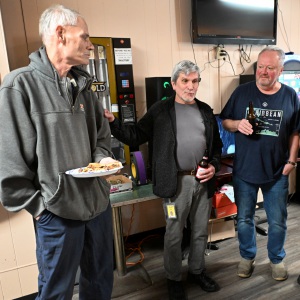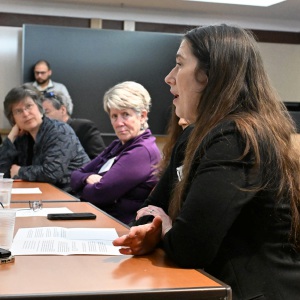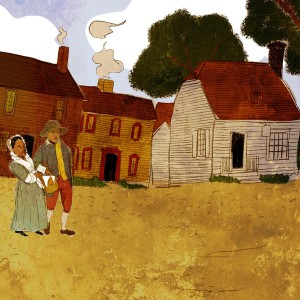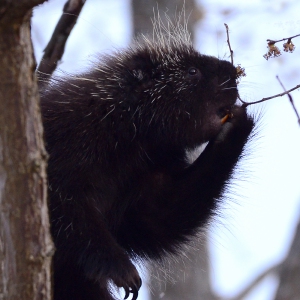Growing in harmony with nature: Montague’s Bigfoot Food Forest shares the benefits of growing ‘three sisters style’
| Published: 12-27-2024 10:11 AM |
Stepping into an animal enclosure after dusk on Friday the 13th, I moved slowly among feathery shapes that appeared grey in December’s early darkness. The full moon, low in the sky, was the only light source; the atmosphere was eerie and wholly enchanting. As my eyes adjusted, I found myself surrounded by dozens of softly clucking, sleepy chickens roosting on bags, bales, and boxes, as well as overhead on poles and beams. The birds’ caretaker let me tag along on purposeful rounds, and in response to my query about how many chickens we were visiting, she replied, “100.”
A Montague farm known as Bigfoot Food Forest is a superb example of the ingenuity and beauty awaiting those who make a habit of visiting hardworking, creative folks in our region. It’s been over three years since we featured Bigfoot’s beginnings; let’s check back in with BabetteWils, the farm’s mastermind. In 2021, Wils and her husband, Mark Somerville, still divided their time between Montague and Needham. Since then, Somerville retired from his position as provost at Olin College of Engineering; the couple now calls Montague home and have made great strides in building their tiny, efficient house and further establishing their 36-acre farm. They’ve doubled their chicken population and added sheep to their flock.
On a recent Saturday, Wils vended at the indoor Farmers’ Market hosted by the Greenfield Public Library. Dried beans of different shapes and hues were stars of the show, along with bags of Red Floriana and Blue Mountain corn kernels, which Wils dipped into to feed an electric grinder. The steady hum and percussive noises serenaded market customers, providing a soundtrack fitting for our farming region.
Wils grows beans that fill the belly with astounding flavor and nutrition. She said that some beans taste better fresh, but that others – like cannellini – are best dried. “Scarlet runners are another great variety to dry,” she said. “The flowers are stupendous and the flavor is wonderful.” Beans are just part of the picture at Bigfoot Food Forest, as Wils and her farming pals experiment with the widely admired Three Sisters method of growing beans, corn, and squash in symbiotic fashion.
Some myths need debunking in order to achieve success. For one thing, the image of tall corn supporting climbing beans surrounded by squash plants effortlessly suppressing weeds is overly simplistic: “I learned that Native Americans didn’t just leave [crop] patches to take care of themselves,” said Wils. “They weeded assiduously.” Wils and her helpers plan to weed next year, and rather than hauling weeds away, they’ll “chop and drop,” adding mulch. “By the time the squash is pretty big, after the weeds slow down, we’ll stop weeding.” Another success strategy, sadly, “is to skip adding our beautiful compost, because it’s chock full of tomato seeds, leading to feral tomatoes overpowering everything else,” said Wils.
When considering corn varieties for the project, Wils said, “Corn that grows tall and has thick stalks is best. Corn mounds are planted in clusters of five, seven, or nine, always an uneven number,” she noted, “and the cluster needs to be strong enough to hold up a couple of pounds of beans plus plant material. The next group is planted four feet away, and each group must be able to withstand strong winds.” Corn that dries well is better than sweet corn, said Wils, “in terms of timing. And three sisters pole beans preferably have a high ratio of vines to beans,” she said. “They need to be able to really hold on.”
Wils decided to grow three sisters style “because I’m intrigued with no-till ways of growing staple, annual crops, and am drawn to regenerative practices. I also like knowing that this was the original farming method in this region.” The approach was likely developed in Central America between 3,000 and 5,000 years ago; the practice came to the Northeast in the last 1,000 years. “This is how Native Americans were farming when Europeans came,” said Wils. “It maintains soil fertility and produces more calories, protein, and complete vitamins than if you grew [the crops] separately.” She cited an experiment where farmers grew one acre each of the crops, alongside an acre of the mixed crops – which ultimately produced between 20% to 50% more.
“Three sisters is a low impact approach,” said Wils. “One of the insights of permaculture is to grow different foods together. Polycultures decrease the need for pesticides and herbicides, and you don’t have to re-fertilize. Sure, it’s labor intensive – you can’t do it with a tractor – but the good news is that you fix nitrogen in the soil and leave crop residue in the fields.”
Article continues after...
Yesterday's Most Read Articles
 Vehicle collides with school bus causing minor injuries in Montague City
Vehicle collides with school bus causing minor injuries in Montague City
 Laid-off Kennametal employees ponder what’s next
Laid-off Kennametal employees ponder what’s next
 AG pledges to help fight opioid crisis in visit to Greenfield
AG pledges to help fight opioid crisis in visit to Greenfield
 Termination of $300K federal grant presents ‘an institutional setback’ for PVMA
Termination of $300K federal grant presents ‘an institutional setback’ for PVMA
 Springfield man held without bail in case of September foot pursuit in Greenfield
Springfield man held without bail in case of September foot pursuit in Greenfield
 HS Roundup: Athol baseball’s bats get rolling in 19-5 win over Turners Falls (PHOTOS)
HS Roundup: Athol baseball’s bats get rolling in 19-5 win over Turners Falls (PHOTOS)
We’ll have to visit Bigfoot Food Forest again sometime, since their chestnut growing project deserves a separate column. As I left the farm after a fascinating visit, Wils indicated her 2024 three sisters plot: “We let the sheep in there, and they pushed over every [plant structure] so they could eat the bean leaves.” At Bigfoot Food Forest, animals and humans make use of every possible nutrient, honor traditional ways, and help to make our planet more harmonious, nutritious and healthy.
To learn more, visit bigfootfoodforest.com.
Eveline MacDougall is the author of “Fiery Hope” and a musician, artist, and descendant of ten generations of farmers in Québec. To contact: eveline@amandlachorus.org.








 Sounds Local: Cover bands abound at the Shea: Big Yellow Taxi will perform much of Joni Mitchell’s ‘Ladies of the Canyon’ this Saturday
Sounds Local: Cover bands abound at the Shea: Big Yellow Taxi will perform much of Joni Mitchell’s ‘Ladies of the Canyon’ this Saturday Speaking of Nature: A surprise in my maple tree: Porcupines just want to find something tasty to eat and be left alone
Speaking of Nature: A surprise in my maple tree: Porcupines just want to find something tasty to eat and be left alone Little pillows of golden goodness: The beignet recipe of your dreams, courtesy of our beloved local Wells Provisions
Little pillows of golden goodness: The beignet recipe of your dreams, courtesy of our beloved local Wells Provisions The cost of addiction: New novel draws on Valley backdrop to explore how substance use upends people’s lives
The cost of addiction: New novel draws on Valley backdrop to explore how substance use upends people’s lives
